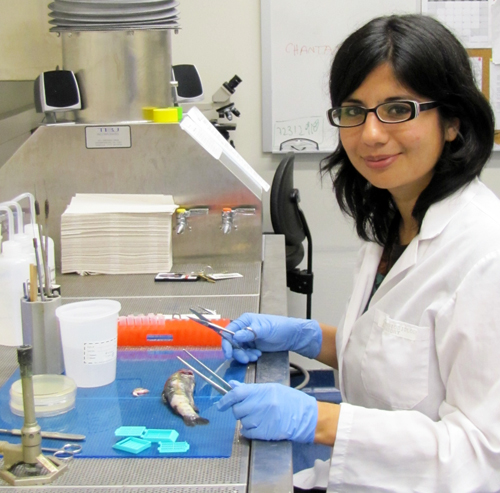
When the Fish Pathology Laboratory receives specimens from fish farms or zoos, determining the cause of death often requires some detective work. Elena Contador, a master’s student in the Department of Pathobiology, is studying a fish disease that has been misunderstood for several decades.
When a new disease was discovered in lake trout in the 1920s, researchers believed it was caused by a Chlamydia-like organism because the lesions were so similar. But they didn’t have the technology to identify the pathogen. The advent of electron microscopy allowed researchers to characterize the pathogen by comparing it to similar bacteria. “Depending on the structure, you can see this looks like a Chlamydia-like organism,” says Contador.
But just because bacteria look alike doesn’t mean they’re the same. “After a lot of tests, I ruled out Chlamydia in the case of this fish,” says Contador, who is studying epitheliocystis, a disease that affects lake trout in Blue Jay Creek on Manitoulin Island. “The disease could also be related to viruses and parasites. We don’t know much about the pathogenesis because the agent hasn’t been cultured in vitro yet.”
Using molecular testing, she identified the bacteria as a member of the burkholderiales order and compared its DNA sequence to a bacterial DNA database. “The DNA that I found using this test in the fish from Blue Jay Creek is really similar to bacteria that was found recently in Europe in fish with epitheliocystis.”
Epitheliocystis causes Chlamydia-like lesions in fish. The disease affects epithelial cells found in the gills, causing lesions and cysts that affect the fish’s ability to breathe. If the fish is experiencing other forms of stress, the disease can be fatal. Some species of burkholderiales have been found in people with compromised immune systems. “When you have a chronic disease and your immune system is busy trying to fight it, these bacteria could take advantage of the situation,” says Contador. “Your system isn’t prepared to fight the disease.”
Burkholderiales bacteria can live in the environment or inside cells. “They usually live in symbiosis with animals that are not vertebrates,” she adds. “They can live inside of amoebas, which prepares them for life inside of a cell.” She believes that when the fish are under stress, the bacteria launch their attack. As with humans, fish are more likely to get sick when they’re stressed, and epitheliocystis in Blue Jay Creek lake trout often strikes in winter when the fish are coping with harsh environmental conditions.
The disease runs its course within five weeks of infection, and the peak mortality rate occurs at around three weeks. “The fish stop dying and they recover,” says Contador. “That probably happens because of the rise in temperature” as the water begins to warm up towards the end of winter. The disease has also been identified in 50 species of freshwater and saltwater fish; it can infect wild and farmed fish. Although the symptoms are similar in each species, the disease may not be caused by the same pathogen, she adds.
It’s unlikely that infected fish would end up in grocery stores or restaurants because fish farmers are not allowed to sell diseased fish, says Contador. Since epitheliocystis also affects the fish’s ability to feed, the fish eats less and doesn’t grow as much, making it unfit to sell.
Contador received her DVM from Universidad Católica de Temuco in Chile and came to U of G with her husband in 2008. She worked as a research assistant while her husband did a master’s degree in fish and nutrition. When he received a scholarship, he decided to pursue a PhD and she began a master’s degree.
What made her focus on bacteria? “I think they are interesting because they are everywhere,” she says. “Sometimes they can be your friend; sometimes they can’t. Why and when they can’t be your friend is what I like to study.”